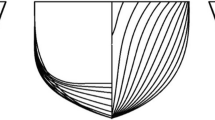Abstract
In this paper, towing tank experiments are conducted to study the behavior of flow on a model of the underwater vehicle with various shapes of bows, i.e. tango and standard bows in free surface motion tests. The total resistances for different Froude numbers are considered experimentally. The towing tank is equipped with a trolley that can operate in through 0.05–6 m/s speed with ±0.02 m/s accuracy. Furthermore, the study is done on hydrodynamic coefficients i.e. total, residual and friction resistance coefficients, and the results are compared. Finally, the study on flow of wave fields around bows is done and wave filed around two bows are compared. The Froude number interval is between 0.099 and 0.349. Blockage fraction for the model is fixed to 0.005 3. The results showed that the residual resistance of the standard bow in 0.19 to 0.3 Froude number is more than the tango bow in surface motion which causes more total resistance for the submarine. Finally, details of wave generated by the bow are depicted and the effects of flow pattern on resistance drag are discussed.
Similar content being viewed by others
References
Alvarez A, Bertram V, Gualdesi V (2009). Hull hydrodynamic optimization of autonomous underwater vehicles operating at snorkeling depth. Jordan Journal of Ocean Engineering, 36(1), 105–112. DOI: 10.1016/j.oceaneng.2008.08.006
Barlow JB, Rae WH, Pope A (1999). Low-speed wind tunnel testing. 3rd edition. John Wiley & Sons, New York, USA, 609–649.
Bertram V (2000). Practical ship hydrodynamics. 1st edition. Butterworth-Heinemann, Kidlington, Oxford, UK, 68–117.
ITTC (2002a). Recommended procedures and guidelines-Model manufacture ship models. Proceedings of the 23rd International Towing Tank Conference, Venice, Italy, 7.5-01-01-01.
ITTC (2002b). Recommended procedures and guidelines-Sample work instructions calibration of load cells. Proceedings of the 23rd International Towing Tank Conference, Venice, Italy, 7.6-02-09.
ITTC (2002c). Recommended procedures and guidelines-Testing and extrapolation methods resistance: Resistance test. Proceedings of the 23rd International Towing Tank Conference, Venice, Italy, 7.5-02-02-01.
ITTC (2002d). Recommended procedures and guidelines-Testing and extrapolation methods resistance: Uncertainty analysis, example for resistance test. Proceedings of the 23rd International Towing Tank Conference, Venice, Italy, 7.5-02-02-02.
Jagadeesh P, Murali K, Idichandy VG (2009). Experimental investigation of hydrodynamic force coefficients over AUV hull form. Ocean Engineering, 36(1), 113–118. DOI: 10.1016/j.oceaneng.2008.11.008
Kwag SH (2000). Bow wave breaking and viscous interaction of stern wave. Journal of Mechanical Science and Technology, 14(4), 448–455. DOI: 10.1007/BF03186439
Kim H, Cho H (2011). Numerical study on control derivatives of a high-speed underwater vehicle. Journal of Mechanical Science and Technology, 25(3), 759–765. DOI: 10.1007/s12206-011-0123-7
Molland AF, Turnock SR, Hudson DR (2011). Ship resistance and propulsion. Cambridge University Press, New York, USA, 14–15. DOI: 10.1017/CBO9780511974113
Moonesun M, Javadi M, Charmdooz P, Mikhailovich KU (2013). Evaluation of submarine model test in towing tank and comparison with CFD and experimental formula for fully submerged resistance. Indian Journal of Geo-Marine Sciences, 42(8), 1049–1056.
Muscari R, Di Mascio A (2004). Numerical modeling of breaking waves generated by a ship’s hull. Journal of Marine Science and Technology, 9(4), 158–170. DOI: 10.1007/s00773-004-0182-x
Roy B, Rydill L (1994). Concepts in submarine design. Cambridge University Press, London, UK, 104–124.
Shahjada Tarafder M, Suzuki K (2008). Numerical calculation of free-surface potential flow around a ship using the modified Rankine source panel method. Ocean Engineering, 35(5–6), 536–544. DOI: 10.1016/j.oceaneng.2007.11.004
Suman KNS, Nageswara D, Das HN, Bhanu Kiran G (2010). Hydrodynamic performance evaluation of an ellipsoidal bow for a high speed under water vehicle. Jordan Journal of Mechanical and Industrial Engineering, 4(5), 641–652.
Van SH, Kim WJ (2006). Flow measurement around a model ship with propeller and rudder. Journal of Experiments in Fluids, 40(4), 533–545. DOI: 10.1007/s00348-005-0093-6
Xie Yi, Ye Qing (2011). Hull form optimization of displacement type deep-vee vessels based on nonlinear programming. International Conference on Electrical and Control Engineering (ICECE), Yichang, China, 2266–2269. DOI: 10.1109/ICECENG.2011.6057745
Zhang Baoji (2012). Shape optimization of bow bulbs with minimum wave-making resistance based on Rankine source method. Journal of Shanghai Jiaotong University, 17(1), 65–69. DOI: 10.1007/s12204-012-1239-3
Author information
Authors and Affiliations
Corresponding author
Rights and permissions
About this article
Cite this article
Javadi, M., Manshadi, M.D., Kheradmand, S. et al. Experimental investigation of the effect of bow profiles on resistance of an underwater vehicle in free surface motion. J. Marine. Sci. Appl. 14, 53–60 (2015). https://doi.org/10.1007/s11804-015-1283-0
Received:
Accepted:
Published:
Issue Date:
DOI: https://doi.org/10.1007/s11804-015-1283-0




